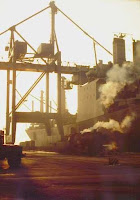
The new signal cantilevers being installed. This is just RR East of Carkeek Park.

Looking RR West from the beach at Carkeek Park, we see the new "Control Point Blue Ridge," with the North Beach neighborhood behind it,. The pair of new crossovers, with high-rail removal point between them, are between the two visible new cantilever signal towers. The North Beach community beach access crossing through the middle of the control point via a new set of steel stairs down from the bluff and a set of wood stairs down to the beach. The Blue Ridge neighborhood and Blue Ridge community beach access are both out of the picture to the left.

Looking further RR East from Carkeek we see a pair of the classic signals such as have characterized this stretch for many years. I think I will enjoy the more dramatic appearance of the new cantilevers more than I will miss the older signals.
[Note that due to constraints of time & laziness, these images were made by telephoto with resulting comprimise of image quality.]
 I found myself wandering out to Edmonds in a bit of a rain the other day, but found a patch of sun when I got there. And a train.
I found myself wandering out to Edmonds in a bit of a rain the other day, but found a patch of sun when I got there. And a train. This Santa Fe unit is a bit the worse for wear. I've long felt that the BNSF Heritage schemes were a big improvement over any of the BN or ATSF schemes -- perhaps because I did much of my early color photography near where these pictures were taken, in the days of Great Northern Orange & Green. In fact I have pictures in almost exactly this location, but from the beach side, of GN Empire Builder scheme SD45s, led by 404, on one of their very first trips West.
This Santa Fe unit is a bit the worse for wear. I've long felt that the BNSF Heritage schemes were a big improvement over any of the BN or ATSF schemes -- perhaps because I did much of my early color photography near where these pictures were taken, in the days of Great Northern Orange & Green. In fact I have pictures in almost exactly this location, but from the beach side, of GN Empire Builder scheme SD45s, led by 404, on one of their very first trips West. In those days, the Ferry was quite likely to be the San Mateo, the last of Washinton State Ferries' steam powered boats. My, she had a lovely whistle.
In those days, the Ferry was quite likely to be the San Mateo, the last of Washinton State Ferries' steam powered boats. My, she had a lovely whistle.















